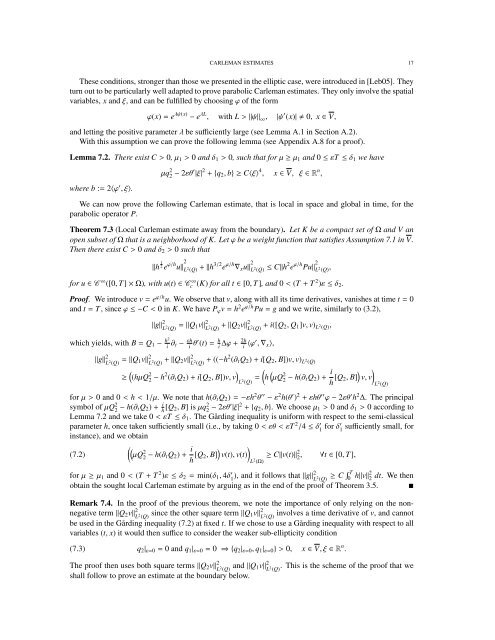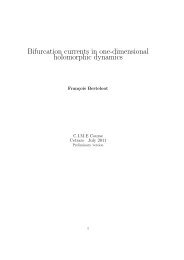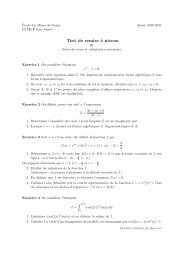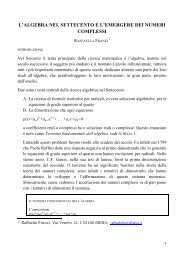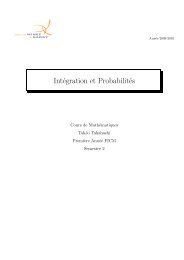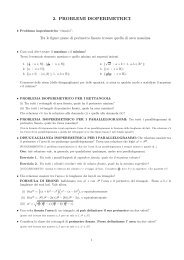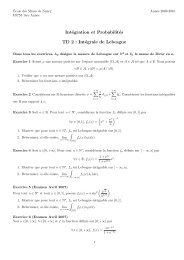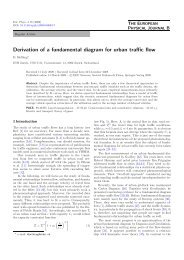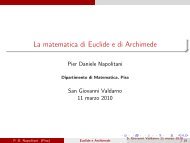on carleman estimates for elliptic and parabolic operators ...
on carleman estimates for elliptic and parabolic operators ...
on carleman estimates for elliptic and parabolic operators ...
Create successful ePaper yourself
Turn your PDF publications into a flip-book with our unique Google optimized e-Paper software.
CARLEMAN ESTIMATES 17<br />
These c<strong>on</strong>diti<strong>on</strong>s, str<strong>on</strong>ger than those we presented in the <strong>elliptic</strong> case, were introduced in [Leb05]. They<br />
turn out to be particularly well adapted to prove <strong>parabolic</strong> Carleman <strong>estimates</strong>. They <strong>on</strong>ly involve the spatial<br />
variables, x <strong>and</strong> ξ, <strong>and</strong> can be fulfilled by choosing ϕ of the <strong>for</strong>m<br />
ϕ(x) = e λψ(x) − e λL , with L > ‖ψ‖ ∞ , |ψ ′ (x)| 0, x ∈ V,<br />
<strong>and</strong> letting the positive parameter λ be sufficiently large (see Lemma A.1 in Secti<strong>on</strong> A.2).<br />
With this assumpti<strong>on</strong> we can prove the following lemma (see Appendix A.8 <strong>for</strong> a proof).<br />
Lemma 7.2. There exist C > 0, µ 1 > 0 <strong>and</strong> δ 1 > 0, such that <strong>for</strong> µ ≥ µ 1 <strong>and</strong> 0 ≤ εT ≤ δ 1 we have<br />
where b := 2〈ϕ ′ , ξ〉.<br />
µq 2 2 − 2εθ′ |ξ| 2 + {q 2 , b} ≥ C〈ξ〉 4 , x ∈ V, ξ ∈ R n ,<br />
We can now prove the following Carleman estimate, that is local in space <strong>and</strong> global in time, <strong>for</strong> the<br />
<strong>parabolic</strong> operator P.<br />
Theorem 7.3 (Local Carleman estimate away from the boundary). Let K be a compact set of Ω <strong>and</strong> V an<br />
open subset of Ω that is a neighborhood of K. Let ϕ be a weight functi<strong>on</strong> that satisfies Assumpti<strong>on</strong> 7.1 in V.<br />
Then there exist C > 0 <strong>and</strong> δ 2 > 0 such that<br />
‖h 1 2 e ϕ/h u‖ 2 L 2 (Q) + ‖h 3/2 e ϕ/h ∇ x u‖ 2 L 2 (Q) ≤ C‖h 2 e ϕ/h Pu‖ 2 L 2 (Q),<br />
<strong>for</strong> u ∈ C ∞ ([0, T] × Ω), with u(t) ∈ C ∞<br />
c (K) <strong>for</strong> all t ∈ [0, T], <strong>and</strong> 0 < (T + T 2 )ε ≤ δ 2 .<br />
Proof. We introduce v = e ϕ/h u. We observe that v, al<strong>on</strong>g with all its time derivatives, vanishes at time t = 0<br />
<strong>and</strong> t = T, since ϕ ≤ −C < 0 in K. We have P ϕ v = h 2 e ϕ/h Pu = g <strong>and</strong> we write, similarly to (3.2),<br />
‖g‖ 2 L 2 (Q) = ‖Q 1v‖ 2 L 2 (Q) + ‖Q 2v‖ 2 L 2 (Q) + i([Q 2, Q 1 ]v, v) L 2 (Q),<br />
which yields, with B = Q 1 − h2<br />
i ∂ t − εh i θ′ (t) = h i ∆ϕ + 2h i 〈ϕ′ , ∇ x 〉,<br />
‖g‖ 2 L 2 (Q) = ‖Q 1v‖ 2 L 2 (Q) + ‖Q 2v‖ 2 L 2 (Q) + ((−h2 (∂ t Q 2 ) + i[Q 2 , B])v, v) L 2 (Q)<br />
≥ ( (hµQ 2 2 − h2 (∂ t Q 2 ) + i[Q 2 , B])v, v ) (h = ( µQ 2 L 2 (Q) 2 − h(∂ tQ 2 ) + i h [Q 2, B] ) )<br />
v, v<br />
<strong>for</strong> µ > 0 <strong>and</strong> 0 < h < 1/µ. We note that h(∂ t Q 2 ) = −εh 2 θ ′′ − ε 2 h(θ ′ ) 2 + εhθ ′′ ϕ − 2εθ ′ h 2 ∆. The principal<br />
symbol of µQ 2 2 − h(∂ tQ 2 ) + i h [Q 2, B] is µq 2 2 − 2εθ′ |ξ| 2 + {q 2 , b}. We choose µ 1 > 0 <strong>and</strong> δ 1 > 0 according to<br />
Lemma 7.2 <strong>and</strong> we take 0 < εT ≤ δ 1 . The Gårding inequality is uni<strong>for</strong>m with respect to the semi-classical<br />
parameter h, <strong>on</strong>ce taken sufficiently small (i.e., by taking 0 < εθ < εT 2 /4 ≤ δ ′ 1 <strong>for</strong> δ′ 1<br />
sufficiently small, <strong>for</strong><br />
instance), <strong>and</strong> we obtain<br />
(7.2)<br />
((<br />
µQ<br />
2<br />
2 − h(∂ t Q 2 ) + i h [Q 2, B] ) v(t), v(t))<br />
L 2 (Ω)<br />
≥ C‖v(t)‖ 2 2 ,<br />
∀t ∈ [0, T],<br />
<strong>for</strong> µ ≥ µ 1 <strong>and</strong> 0 < (T + T 2 )ε ≤ δ 2 = min(δ 1 , 4δ ′ 1 ), <strong>and</strong> it follows that ‖g‖2 L 2 (Q) ≥ C ∫ T<br />
0 h‖v‖2 2 dt. We then<br />
obtain the sought local Carleman estimate by arguing as in the end of the proof of Theorem 3.5. <br />
Remark 7.4. In the proof of the previous theorem, we note the importance of <strong>on</strong>ly relying <strong>on</strong> the n<strong>on</strong>negative<br />
term ‖Q 2 v‖ 2 L 2 (Q) since the other square term ‖Q 1v‖ 2 L 2 (Q)<br />
involves a time derivative of v, <strong>and</strong> cannot<br />
be used in the Gårding inequality (7.2) at fixed t. If we chose to use a Gårding inequality with respect to all<br />
variables (t, x) it would then suffice to c<strong>on</strong>sider the weaker sub-<strong>elliptic</strong>ity c<strong>on</strong>diti<strong>on</strong><br />
L 2 (Q)<br />
(7.3)<br />
q 2 | ε=0 = 0 <strong>and</strong> q 1 | ε=0 = 0 ⇒ {q 2 | ε=0 , q 1 | ε=0 } > 0, x ∈ V, ξ ∈ R n .<br />
The proof then uses both square terms ‖Q 2 v‖ 2 L 2 (Q) <strong>and</strong> ‖Q 1v‖ 2 L 2 (Q)<br />
. This is the scheme of the proof that we<br />
shall follow to prove an estimate at the boundary below.


